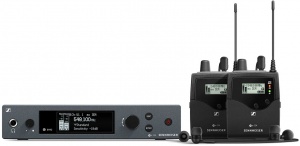In Ear Monitors for an L1 User
Contents
- 1 {| class="" id="" align="center" style="max-width: 60em; text-align:center;" |colspan="2" style="border:1px solid #336699; border-top:1px solid #336699; background-color: #dfefff; padding: 0.5em 0.5em 0.5em 0.5em; text-align:center;" | This article expresses my opinion and experience. Please post comments link to forum discussion (optional) e.g. discussion in the Bose Message Board. Thank you — User:ST. |- |}
- 2 First Time Setup
- 3 First Impressions
- 4 Later Impressions
- 5 Why UHF instead of 2.4 Mhz Digital
- 6 Why the Twin System
{| class="" id="" align="center" style="max-width: 60em; text-align:center;"
|colspan="2" style="border:1px solid #336699; border-top:1px solid #336699; background-color: #dfefff; padding: 0.5em 0.5em 0.5em 0.5em; text-align:center;" |
This article expresses my opinion and experience. Please post comments link to forum discussion (optional) e.g. discussion in the Bose Message Board.
Thank you — User:ST.
|-
|}
EW IEM G4 Twin I just got my In-Ear-Monitors. Sennheiser EW IEM G4 - Double Wireless In-Ear-Monitor-System
I normally run my PA (Bose L1 behind me). I don't have separate monitors. I wanted to try in-ear-monitors for a change.
First Time Setup
The Sennheiser system worked out of the box. I took time to get to learn the details several hours into the experience of hearing myself in this new way. I connected the headphone output of my T8S ToneMatch Mixer to the inputs of the transmitter to try things out quickly.
First Impressions
- Guitar
The guitar through the Kemper Profiler sounds great through the in-ear-monitors, but to put that into context, I'm used to hearing it through my L1 Pro32. It's not massively different.
- Vocals
I usually run the vocals dry in the PA (no reverb or time-related effects) because there's usually plenty of natural reverberation in the room. That means the headphone mix is dry, too - drier than what I usually hear (voice in the room sound). That's okay. I don't mind.
It will take some time to get used to the occlusion effect (try singing with your fingers in your ears). The guitar sounds fine. My voice sounds funny. When I have more time, I'll set up a proper monitor mix to control the vocal and guitar levels separately.
I'll need to rehearse with the in-ear-monitors to get used to hearing myself that way.
Later Impressions
Several hours later.
Wow - I wish I had gotten wireless in-ear-monitors sooner.
The best part is the wireless. Back when I had to consider the neighbours and cohabitants, I would occasionally play with headphones. I hated it - mostly because I play standing up and I wander around. Within minutes I was a tangled mess. You find out quickly if you tend to turn in one direction when there are cables involved. I went wireless for the guitar a long time ago, which made using headphones all the more vexing.
Remember the first time you played wireless with your guitar on stage? I got to relive that all over again with wireless monitoring.
I'm still getting used to the earbuds and the occlusion effect when I'm singing. When I want to give that a rest, I can use regular headphones that plug into the wireless receiver. My Bose NC 700 headphones work fine.
The initial setup was drop-dead simple, but there are plenty of options, including a limiter so I won't blow out my ears.
Why UHF instead of 2.4 Mhz Digital
If you're wondering why I went with a UHF system instead of one of the less expensive 2.4 MHz systems - it's because the 2.4 MHz range is crowded. I don't want to get to a gig and find that all the available channels are occupied by the ubiquitous wireless guitar and microphone systems.
Why the Twin System
I got the package deal with two receivers for two reasons.
- The system is stereo, but you can split the signals and have two monitor mixes - one for each receiver
- You can run remote loudspeakers for larger venues in stereo or dual mono.
Articles and Discussions
Replacing Studio Monitors with In Ear Monitors — Reddit
